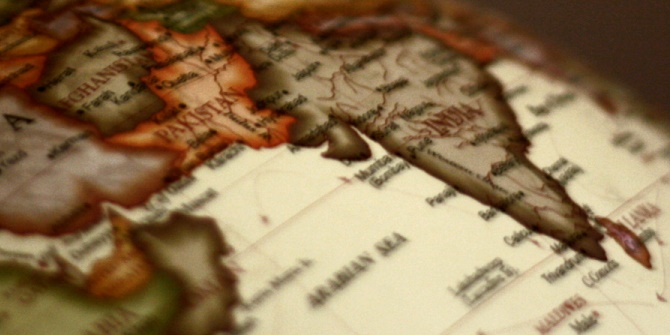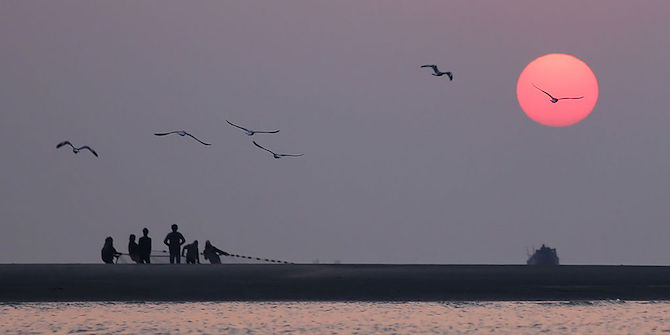Raj Verma discusses the key challenges that threaten to South Asian stability in 2016, from tensions between India and Pakistan, India’s “unofficial blockade” of Nepal, Afghan instability and the renewed rise of Islamic fundamentalism in the region.
The South Asia sub-continent is dominated by India, the regional hegemon. As a result, most of the foreign policy challenges faced by South Asia reflect India’s relations with its neighbours. The complex India-Pak relations have been further convoluted and securitised in recent years due to a renewed nuclear arms race which does not bode well for South Asia, or indeed the rest of the world. India-Nepal relations are once again in the spotlight following the promulgation of the Himalayan nation’s new constitution. Afghanistan, Pakistan, Bangladesh and India are facing a threat from rising Islamic fundamentalism and terrorism, and non-state actors such as the Islamic State (IS) and Al-Qaeda pose serious domestic and foreign policy challenges for the region in 2016.

India–Pakistan relations: The South Asian neighbours have fought three wars since partition, and Kashmir and cross-border terrorism have led to ongoing tensions which periodically spill over into open conflict. The bilateral relationship is further convoluted by both countries ties with other key players, namely the US, China, and Afghanistan. It is made even more complex by the over-simplified media headlines and misunderstanding of each other’s strategic thinking and domestic politics. Harangue
The India-Pakistan relationship has oscillated in 2015. At the Ufa Summit in Russia, the Prime Ministers decided that National Security Advisors (NSAs) from the two countries would meet and discuss all issues related to terrorism (excluding Kashmir). However, the meeting was cancelled in August. In December, during the Minister of External Affairs Sushma Swaraj’s visit to Islamabad, India announced its decision to resume dialogue with Pakistan.
Analysts have divergent opinions on the on the resumption of talks and indeed whether India should engage with Pakistan at all. Optimists point out that there is an acceptance on the part of Pakistan that its Kashmir policy is a failure. Pakistan will continue to support Kashmir but to a lesser extent and it will need India’s help in reducing its involvement and talks will allow Pakistan to save face. Pessimists argue that every time India enters into a dialogue with Pakistan there is increase in terrorism from across the border. The rationale is that lack of dialogue gives rise to uncertainty about how India will react to aggression, whereas talks acts as a buffer to any offensive action on India’s part. It is also argued that resumption of talks is due to pressure from the US on India and from China on Pakistan.
India and Pakistan have also exchanged heavy fire across the International Border and the Line of Actual Control and the incidence and intensity has increased significantly from the Indian side which according to some analysts sends a strong message to Pakistan. In December 2014, Prime Minister Sharif vowed that Pakistan would wipe out all terrorists – good or bad – following the Peshawar school attack which 141 people were killed. Despite this, Pakistan continues to distinguish between ‘good terrorists’ and ‘bad terrorists’ and cross border terrorism will emanate from Pakistan in the New Year. To ensure stability of the region in 2016, it is necessary for India and Pakistan to show greater understanding of each other’s strategic thinking and domestic politics, but this is easier said than done.
Afghanistan: One of the most important foreign policy challenges for both South Asia and the international community in 2016 is to ensure a secure Afghanistan. However, the increase in political instability, insecurity and terrorism after the withdrawal of the NATO troops in December 2014 is a major cause for concern. An unstable Afghanistan could have a domino effect and spread instability and regime collapse in the adjoining regions. It is already a hotbed of terrorists and jihadists from different parts of the world: in addition to Al Qaeda and the Islamic State (IS), terrorist organisations like the Islamic Party of Uzbekistan (formerly Islamic Movement of Uzbekistan), Tehrik-e-Taliban Pakistan (TTP), Lashkar-e-Taiba, Haqqani Network and Lashkar-e-Janghvi among others use Afghanistan as a springboard for terrorist activities in South Asia and elsewhere.
The Afghan Taliban has become resurgent in 2015, contributing to the country’s slow descent towards chaos. The attacks in Kabul, the capture of Kunduz and the recent gains in Helmand illustrate the inability of the Afghan National Army (ANA) and the Afghan National Police (ANP) to defeat the Taliban. It is for this reason that the US did not completely withdraw troops from Afghanistan. Using carrots and/or sticks, Pakistan should be made to understand that its policy of ‘strategic depth’ is leading to instability in Afghanistan and beyond, and concerted attempts should be made to foster and enhance Afghan government’s reconciliation with the Afghan Taliban. The country needs investment, technical assistance, development aid, military assistance and training for the ANA and ANP, and government officials in order to strengthen state institutions and provide better governance.
Renewed rise of Islamic fundamentalism and terrorism: Islamic fundamentalism and terrorism is not new to South Asia. However, the problem has been exacerbated by the emergence of and possibility of spread of Al-Qaeda and more recently IS in Afghanistan, Pakistan, India and Bangladesh. There is lack of consensus amongst analysts and government officials about the emergence and spread of IS in South Asia. Some believe IS is gaining ground. Others agree that although the IS may have sympathisers in the region, it is likely to be a long time before it manifests itself physically, if at all.
Both Pakistan and Afghanistan are promising bases for the IS, and Pakistan in particular offers a bonanza in the form of nuclear weapons. On the other hand, IS may face stiff competition with the well-entrenched and well-armed extremist groups that already exist. Young and disgruntled Sunni youth look at Al Qaeda with disdain, but the group still has a large following, a vestige of the Soviet-Afghan war. However, it is possible that some of the other militant groups may have shifted allegiance from Al-Qaeda to IS or broken from the parent organisation to create pro-IS splinter groups.
Some of the disgruntled Taliban commanders have already started actively recruiting in the name of IS in the Helmand province in Afghanistan which has led to clashes between Taliban and IS sympathisers. In Nangarhar, an eastern province in Afghanistan, IS has established a stronghold. It controls several districts and has started a radio broadcast in Pashto called the “Voice of the Caliphate” to attract new recruits. The group has 1000-3000 members in Afghanistan and its influence will spread if it is not stymied. On July 10 2014, Tehreek-e-Khilafat, a militant group under the TTP pledged allegiance to the IS and there is a possibility that other factions may join the IS. The common factor is hostility towards Shia Muslims, but increasing support for IS and other extremist groups may also lead to more attacks against moderate Sunnis in both countries. It could also provide the IS with an opportunity to use the region to attack Shia Iran and further complicate Afghan government’s reconciliation with the Afghan Taliban.
India and Bangladesh also face challenges due to Islamic fundamentalism, albeit to a lesser degree than in Pakistan and Afghanistan. Al Qaeda and the IS have identified the potential of the large Sunni Muslim population in India, and winning hearts and minds in the South Asian hegemon is ideologically and strategically appealing for both groups. In 2014, Ayman al-Zawahiri declared the establishment of an AQ Indian-affiliate known as al-Qaeda in the Indian Subcontinent (AQIS), which has links with jihadis in Pakistan and Afghanistan. The publication of an article by Maulana Esam Umar titled “The Future of Muslims in India,” in Al Qaeda’s first English-language magazine Resurgence underlined Al Qaeda’s interest in India’s Sunni Muslim population. IS has also made attempts to influence Indian Muslims, using local languages such as Hindi, Bengali and Punjabi to attract recruits. On November 18 2015, the Ministry of Home Affairs in India issued an advisory of attacks backed by IS in the country.
Indian Muslims have (by and large) been immune to the lure of radicalism. However, 23 Indian Muslims are known to be fighting for the IS in Iraq and Syria and IS propagandists and followers have been arrested in India. Ansar-ul-Tawhid fi Bilad al Hind, a terror group based in Afghanistan-Pakistan with Indian Jihadists has recently been associated with the IS. According to the National Investigative Agency, an Indian intelligence organisation, the Indian Mujahideen wanted to be the IS in India. On December 17, the head of AQIS was arrested in New Delhi.
IS influence has also reached Bangladesh. On September 1 2015, Abdullah al-Tasnim, self-proclaimed emir of Jamaat al-Mujahideen Bangladesh (which also has a presence in some border areas in India) and six members were arrested by police for plotting to assassinate VIPs, planning attacks against government installations and seeking to travel to Syria to fight for the IS. In September, police arrested Saimun Rahman, a UK citizen of Bangladeshi origin of attempting to recruit people to fight in Syria, along with 30 followers of the IS. In November, the IS claimed that it had appointed a regional leader in Bangladesh although it did not name him. It has also claimed responsibility for injuring an Italian priest and killing an Italian aid worker and a Japanese agriculturalist.
The rivalry between Al Qaeda and the IS which could therefore lead to grave security implications in the sub-continent. Either group or both groups may provoke tensions between India and Pakistan to garner support and recruits. Additionally, a significant radicalisation of Sunni Indian population could lead to intra-sectarian violence among Indian Muslims which does not bode well for domestic security in India or India-Pak relations.
Nuclear instability and the arms race in South Asia: Indo-Pak rivalry has also manifested itself in the realm of nuclear weapons. India and Pakistan have approximately 100 and 120 nuclear warheads respectively, and Pakistan continues to increase its nuclear arsenal. It is estimated that at current levels of production, in ten years, Pakistan will have the third largest arsenal with approximately 350 fission warheads. It has also shifted its strategy from ‘minimum credible deterrence’ to ‘full spectrum deterrence’ which has led to the development of battlefield or ‘tactical nuclear weapons’ (TNWs). The purpose of the shift is to ensure that Pakistan does not suffer a defeat in conventional conflict with India, and to prevent further escalation to the level of strategic nuclear weapons. Meanwhile India’s nuclear doctrine allows for a massive retaliatory strike to cause unacceptable damage even in the event of a small nuclear attack. Reports also suggest that India is planning to produce a hydrogen or fusion bomb and plans to enhance production of nuclear fuel for nuclear powered submarines.
Whether nuclear weapons will prevent war between India and Pakistan is debatable. However, the use of TNWs in the event of a conflict is likely to impact Pakistan’s army, its border population and cause significant damage – both immediate and latent – to the Indian population. It could also easily spill over to full scale nuclear war. Moreover, the deployment of TNWs makes it difficult to prevent accidental use or protect them from terrorists or jihadists. In 2016 and beyond, a major foreign policy challenge for India, Pakistan, the US and the region would be to persuade Pakistan that its nuclear arsenal is big enough to deter India and prevent it from building and deploying TNWs.
India-Nepal relations: Nepal and India share deep historical, religious and cultural links and India has considerable influence over Nepal. During Prime Minister Modi’s visit to Nepal in August 2014, India and Nepal agreed to “review, adjust and update” the 1950 Treaty of Peace and Friendship to “better reflect the current realities” and expand ties in “a forward looking manner.” However, on September 20 2015, Nepal adopted a new constitution after eight years of deliberation. India immediately expressed its displeasure and asked Nepal to make seven amendments to address the concerns of minority groups in Nepal, such as the Madhesis and the Janjatis. Nepal’s failure to comply resulted in India “unofficially blockading” its Himalayan neighbour, leading to critical shortages of fuel and other essentials. According to some estimates the ‘blockade’ caused more damage to Nepal than the earthquake on April 25 2015. Approximately fifty people have died since the demonstrations started on September 24, and on December 22, Nepal decided to make amendments to the constitution.
In the future, cautious use of soft power and diplomacy rather than heavy-handed tactics would be a better way for India to express its concerns. There is scope for increased engagement between the two countries. However, it is hampered due to India’s bullying and interference in the domestic affairs of Nepal which have given rise to suspicions and mistrust regarding its intentions in Nepal. In 2016, India’s meddling in Nepal will continue which will affect joint investments in infrastructure and river projects. It also creates challenges for the bilateral relationship, as the recent episode has created deep anti-India sentiment in Nepal. Indian actions have also opened opportunities for China in Nepal which may cause further tensions in the long term, raising questions over India’s foreign policy decision making processes.
Note: This article gives the views of the author, and not the position of the South Asia @ LSE blog, nor of the London School of Economics. Please read our comments policy before posting.
About the Author
Raj Verma is Assistant Professor at the School for International Relations and Public Affairs, Jilin University, China; Fudan Senior Fellow, Gandhi Institute, Fudan University, China and Visiting Fellow, Institute for Defence Studies and Analyses, India. He is a former Visiting Fellow at the Centre for International Studies, LSE and regular contributor to South Asia @ LSE – read his previous posts here.







